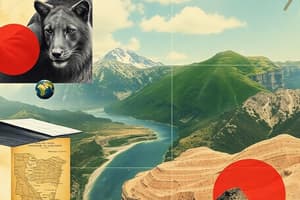Podcast
Questions and Answers
What mountain has the highest elevation in the world?
What mountain has the highest elevation in the world?
- Everest (correct)
- K-2
- Annapurna
- Lhotse
Which ocean has the greatest average depth?
Which ocean has the greatest average depth?
- Southern Ocean
- Atlantic Ocean
- Indian Ocean
- Pacific Ocean (correct)
Which continent has the largest area?
Which continent has the largest area?
- North America
- Asia (correct)
- South America
- Africa
What is the average depth of the Atlantic Ocean?
What is the average depth of the Atlantic Ocean?
Which of the following mountains is located in Pakistan?
Which of the following mountains is located in Pakistan?
What does the term geography originate from?
What does the term geography originate from?
What is the primary purpose of the five themes of geography?
What is the primary purpose of the five themes of geography?
Which of the following describes the theme 'Region' in geography?
Which of the following describes the theme 'Region' in geography?
What is meant by 'Movement' in the context of geography?
What is meant by 'Movement' in the context of geography?
What three types of distance are mentioned in the content?
What three types of distance are mentioned in the content?
Which layer of the Earth is closest to the surface?
Which layer of the Earth is closest to the surface?
What is a key factor that allows life to exist on Earth?
What is a key factor that allows life to exist on Earth?
What is the rate of movement for tectonic plates mentioned in the content?
What is the rate of movement for tectonic plates mentioned in the content?
Study Notes
Definition and Themes of Geography
- Geography originates from Greek terms "geo" (earth) and "graphia" (description).
- It involves the scientific study of the physical characteristics of the Earth.
- In 1984, the National Council for Geographic Education (NCGE) and the Association of American Geographers (AAG) outlined five key themes of geography for simplified understanding.
Five Themes of Geography
- Region: A defined area unified by similar physical and cultural characteristics.
- Human-Environment Interaction: Examines how humans adapt to and modify their environment, including resource usage and adaptation to changes.
- Movement: Focuses on the migration of people and the transfer of goods and natural phenomena (e.g., wind, rain).
- Place: Defines the uniqueness of a geographical location characterized by its physical and human attributes.
- Location: Includes the geographic coordinates of a place, encompassing absolute and relative location.
Earth's Structure
- Earth is one of eight planets in the solar system, orbiting the Sun.
- Life on Earth relies on energy from the Sun, critical for sustaining ecosystems.
- The planet's structure comprises three main layers: crust, mantle, and core.
Hemispheres
- Earth is divided into four hemispheres:
- Northern Hemisphere and Southern Hemisphere are divided by the Equator.
- Eastern Hemisphere and Western Hemisphere are divided by the Prime Meridian.
Plate Tectonics
- Tectonic plates move very slowly at about 5 centimeters (2 inches) per year.
- Their movement causes earthquakes, volcanic eruptions, and mountain formations like the Himalayas.
- Over millions of years, continental positions on Earth significantly change.
Notable Mountains
- The world's highest peaks include:
- Mount Everest: 8,848 meters, located in Nepal/Tibet.
- K2: 8,611 meters, Pakistan.
- Other notable peaks, all in Nepal or its vicinity, include Kangchenjunga, Lhotse, Makalu, and Cho Oyu.
Oceans of the World
- Oceans cover vast areas with varying depths:
- Pacific Ocean: 155,557,000 sq.km, average depth of 12,926 feet, home to the Mariana Trench.
- Atlantic Ocean: 76,762,000 sq.km, average depth of 11,730 feet, featuring the Puerto Rico Trench.
- Indian Ocean: 68,556,000 sq.km, average depth of 12,596 feet, including the Java Trench.
- Southern Ocean: 20,327,000 sq.km, average depth of 13,100 feet.
- Arctic Ocean: 14,056,000 sq.km, average depth of 3,407 feet.
Continents of the World
- The seven continents with their respective areas:
- Asia: 44,614,000 sq.km.
- Africa: 30,218,000 sq.km.
- North America: 24,230,000 sq.km.
- South America: 12,814,000 sq.km.
- Antarctica: 14,245,000 sq.km.
- Europe: 10,505,000 sq.km.
- Australia and Oceania: 8,503,000 sq.km.
Studying That Suits You
Use AI to generate personalized quizzes and flashcards to suit your learning preferences.
Description
Explore the definition and five key themes of geography. This quiz will help you understand the scientific study of the Earth's physical characteristics and how these themes have been structured to simplify learning. Suitable for students of geography and related fields.




